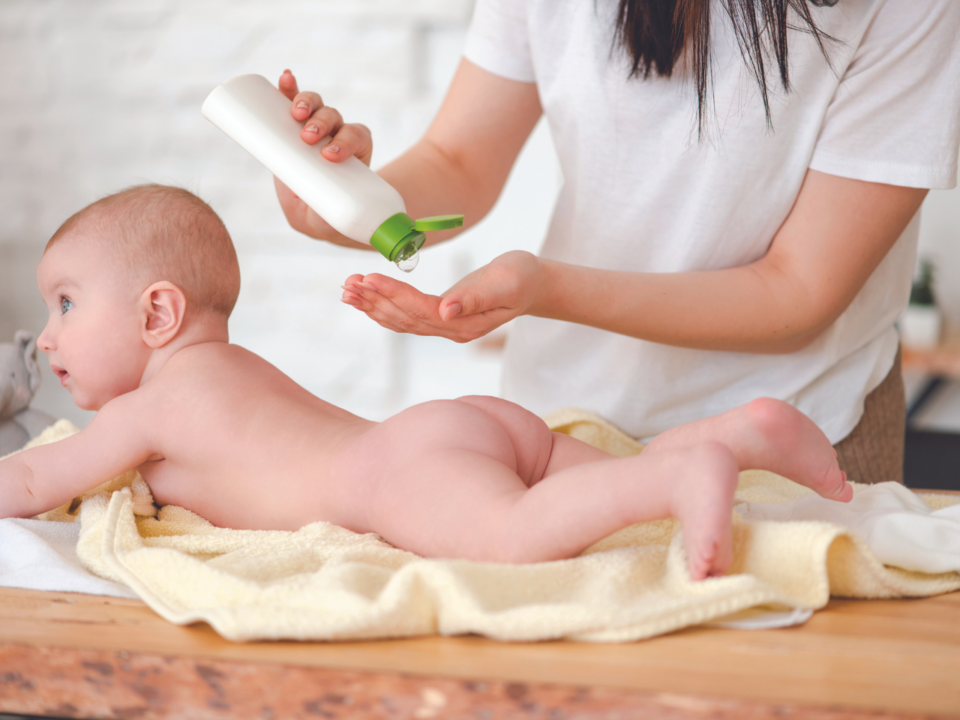The scariest part of being a first-time parent is not being unsure of what to do but knowing that baseline is just keeping your baby alive. The second scariest part is dealing with everything that always crops up after you’re totally confident that you can keep your baby alive. If it isn’t their first-ever cold, it’s some kind of skin issue. Amie Shanon, M.D. with The Dermatology Clinic of Baton Rouge shared some advice on how to care for your baby’s skin and tackle any problems that may arise.
How do I care for my baby’s skin day-to-day?
Most daily skincare means paying attention to bathtime. However, most babies don’t actually need a daily bath to keep clean, despite this being a common practice for developing a bedtime schedule. Dr. Shanon recommends bathing twice or thrice a week or every other day.
“This is actually quite better for their skin microbiome and can promote healthy skin bacteria if they are in the neonatal period and taken care of in the home environment,” shares Dr. Shanon.
Of course, after bath time comes lotions. Since infant skin is typically very sensitive, it’s best to stray from scented lotions that can worsen dry skin or issues like eczema. Fragrance-free, hypoallergenic moisturizers are going to be your best friend. Dr. Shanon suggests trying the brands Cetaphil, CeraVe, and Vanicream but warns that marketing ploys that use the word “baby” in the product’s name doesn’t mean it’s good for your baby–it may contain soft-scented fragrances and, therefore, irritants.
If your baby is premature, extra care needs to be taken when moisturizing. “In regards to premature infants, their skin is extra-fragile because it doesn’t hold moisture well due to its immaturity,” warns Dr. Shanon. “Petroleum jelly can lock in moisture best in their case.”
What do I do if a rash appears?
Take a deep breath! Even if you do everything right, rashes still happen, and of course, they’re scary.
“Lots of newborn and infantile rashes can have dramatic appearances and frighten parents easily, I think. The first thing to do is: don’t panic,” advises Dr. Shanon.
She suggests you try to think clearly and start asking yourself these simple, quick questions:
- Is there a fever associated with the rash? Call your pediatrician or dermatologist if so.
- Is my child bothered or seems uncomfortable by it?
- Has he/she been sick lately or currently with cough, runny nose, watery eyes, or GI symptoms?
- Is he/she eating and interested in their usual activities?
- Are there others sick at daycare or in the home?
- Is there anything new in their diet, environment, or any new pets?
When do I see a physician?
If we’re being honest, sometimes rashes resolve with time without any intervention, but other times, treatment is needed to make sure your baby is back in tip-top shape. There are a handful of symptoms to look out for that signal the need for a physician to intervene.
“A parent should contact a physician when fever or other symptoms accompany a rash, if the baby seems irritated by the rash, the rash is spreading or increasing in intensity, or if it lasts beyond 24-48 hours,” explains Dr. Shanon.
If you do decide to see a physician, they’re going to need pictures of the rash. Snap a few photos of the rash with your phone’s camera. Dr. Shanon notes that photos are often helpful if you get referred to a dermatologist because they like to see how the rash progresses with time. Having these photos can help them form a diagnosis.
All in all, if you’re worried or unsure if the rash is serious, visiting a physician can help assuage your concerns.
What about eczema?
If your baby has been diagnosed with eczema or atopic dermatitis, you’ve probably gotten lots and lots of wacky advice from strangers and relatives alike on how to treat it. Your doctor understands that this skin condition can be a daunting task to handle day-to-day. This condition is believed to affect 1 in 4 children in the US, and while there is no cure, many kids will outgrow it.
In the meantime, Dr. Shanon’s eczema care tips include:
- Gentle bathing with lukewarm water and fragrance-free cleansers
- Spending no longer than 5-10 min in the bath without scrubbing the skin
- Apply moisturizer directly after a bath when skin is still damp
- Identify triggers and eliminate them if possible (tobacco smoke, sweat, saliva, pet dander, pollen, grasses, baby wipes, etc.)
- Apply a thin layer of Vaseline to cheeks before feedings to help protect skin from food irritants and saliva
- See a board-certified dermatologist for customized skincare regimens if needed
Suncare instructions, please!
While we’re well on our way into fall, that doesn’t mean suncare isn’t important–especially for fragile infant skin.
“Don’t forget sun protection for end-of-summer activities, for sure! You still can get burned on those cloudy days! Really avoiding sun exposure in the very young is the best protection for them,” says Dr. Shanon.
She also explains that sunscreens are generally harmless, but since they haven’t been studied under 6 months of age, the FDA does not advise them for this age group. However, you aren’t out of luck if you can’t dress your baby head-to-toe for complete coverage. Sunblock that contains zinc oxide (the same ingredient in diaper rash creams) or titanium dioxide only is recommended in these cases since these products sit on top of the skin and are not absorbed.
Ultimately, the best thing you can do is stay calm and document any changes in your baby’s skin that affect their mood and quality of life. Not every parent has friends or family readily available to give advice, so if you need advice or just some reassurance, Dr. Shanon assures that help is just a phone call away.

